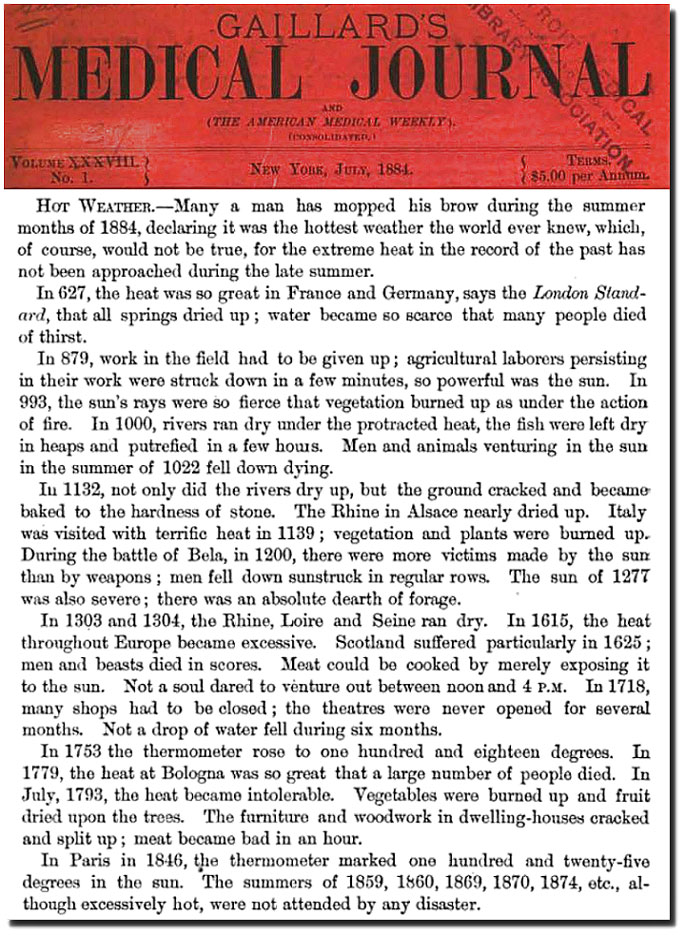 |
Weather Eye with John Maunder |
'Hot Weather.—Many a man has mopped his brow during the summer months of 1884, declaring it was the hottest weather the world ever knew, which, of course, would not be true, for the extreme heat in the record of the past has not been approached during the late summer.
In 627, the heat was so great in France and Germany, says the "London Standard", that all springs dried up; water became so scarce that many people died of thirst.
In 879, work in the field had to be given up; agricultural laborers persisting in their work were struck down in a few minutes, so powerful was the sun. In 993, the sun's rays were so fierce that vegetation burned up as under the action of fire. In 1000, rivers ran dry under the protracted heat, the fish were left dry in heaps and putrefied in a few hours. Men and animals venturing in the sun in the summer of 1022 fell down dying.
In 1132, not only did the rivers dry up, but the ground cracked and became baked to the hardness of stone. The Rhine in Alsace nearly dried up. Italy was visited with terrific heat in 1189; vegetation and plants were burned up. During the battle of Bela, in 1200, there were more victims made by the sun than by weapons ; men fell down sunstruck in regular rows. The sun of 1277 was also severe; there was an absolute dearth of forage.
In 1303 and 1304, the Rhine, Loire and Seine ran dry. In 1615, the heat throughout Europe became excessive. Scotland suffered particularly in 1625 ; men and beasts died in scores. Meat could be cooked by merely exposing it to the sun. Not a soul dared to venture out between noon and 4 p.m. In 1718, many shops had to be closed; the theatres were never opened for several months. Not a drop of water fell during six months.
In 1753 the thermometer rose to one hundred and eighteen degrees. In 1779, the heat at Bologna was so great that a large number of people died. In July, 1793, the heat became intolerable. Vegetables were burned up and fruit dried upon the trees. The furniture and woodwork in dwelling-houses cracked and split up; meat became bad in an hour.
In Paris in 1846, the thermometer marked one hundred and twenty-five degrees in the sun. The summers of 1859, 1860, 1869, 1870, 1874, etc., although excessively hot, were not attended by any disaster.”
Gaillard's Medical Journal – Google Books
'STATISTICS OF HOT SUMMERS.
The excessive heat which prevails. at present (says a Paris paper) gives some interest to the following account of remarkably hot summers :—” In 1132 the earth opened, and the rivers and spring; disappeared in Alsace. The Rhine was dried up. In 1152 the heat was so great that eggs were cooked in the sand. In 1160, at the battle of Bela, a great number of soldiers died from the heat. In 1276 and 1277, in France, there was an absolute failure of the crops of grass and oats. In 1303 and 1304, the Seine, the Loire, the Rhine, and the Danube, were passed over dry-footed. In 1393 and 1394, great numbers of animals fell dead, and the crops were scorched up. In 1440 the heat was excessive. In 1538, 1539, 1540, 1541, the rivers were almost entirely dried up. In 1556 there was a great drought over all Europe. In 1615 and 1616, the heat was overwhelming in France, Italy, and the Netherlands. In 1646 there were fifty-eight consecutive days of excessive heat. In 1678 excessive heat. The same was the case in the first three years of the 18th century. In 1718 it did not rain once from the month of April to the month of October. The crops were burnt up ; the riven were dried up, and the theatres were closed by decree of the Lieutenant of Police. The thermometer marked 36 degrees Reaumur (113 of Fahrenheit). In gardens which were watered, fruit trees flowered twice. In 1723 and 1724, the heat was extreme. In 1746, summer was very hot and very dry, which absolutely calcined the crops. During several months no rain fell. In 1748, 1754, 1760, 1767, 1778, and 1749, the heat was excessive. In 1811, the year of the celebrated comet, the summer was very warm and the wine delicious, men at Semmes. In 1818 the theatres were closed for nearly a month, owing to the heat. The maximum heat was 35 degrees (110.75 Fahrenheit.) In 1830, whilst fighting was ending on the 27th. 28th, and 29th July, the thermometer marked 36 degrees centigrade (97.75 Fahrenheit). In 1832, in the insurrection of the 5th and 6th of June, the thermometer marked 35 degrees centigrade. In 1695 the Seine was almost dried up. In 1850, in the month of June, on the second appearance of the cholera, the thermometer marked 34 degrees centigrade. The highest temperature which man can support for a certain time varies from 40 to 45 degrees (104 to 113 of Fahrenheit.) Frequent accidents, however, occur at a less elevated temperature.”
Source: From a Guest column from "RealClimateScience.com" and shown on the Cornwall Alliance.org web site


